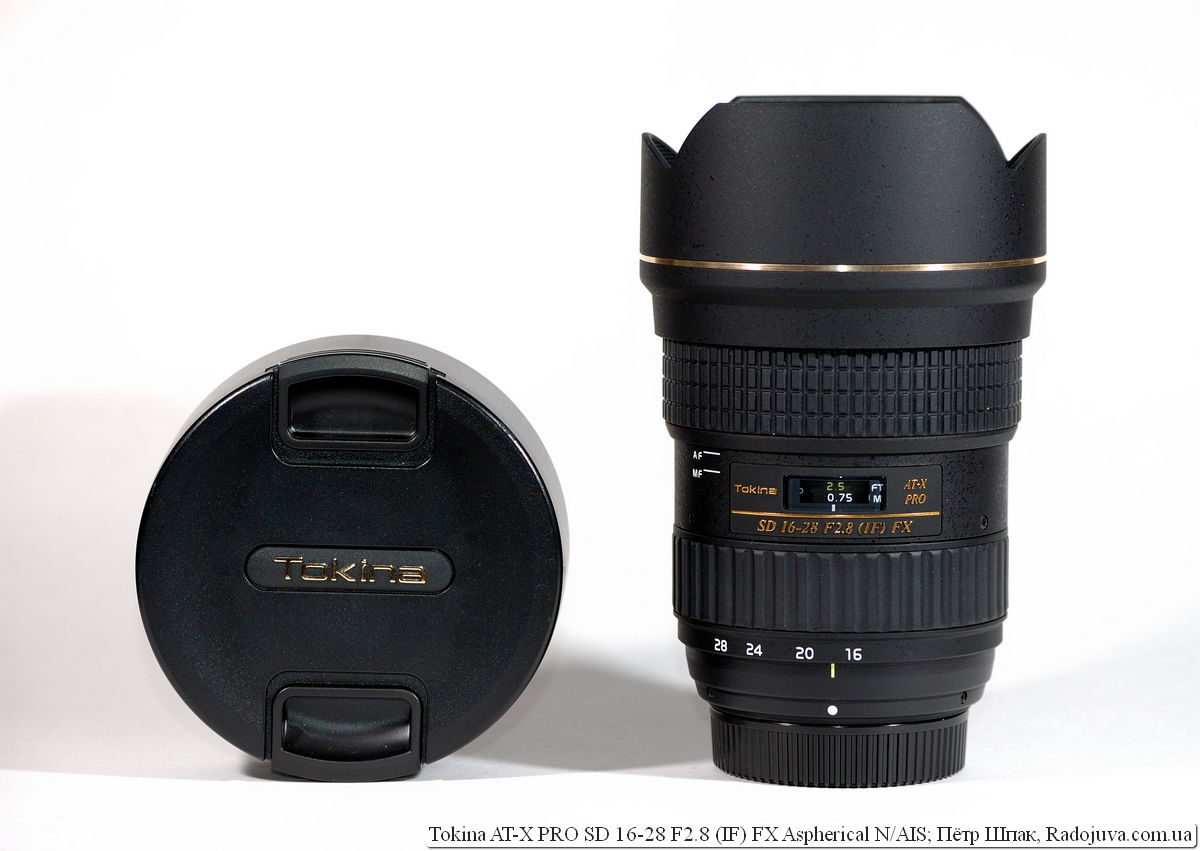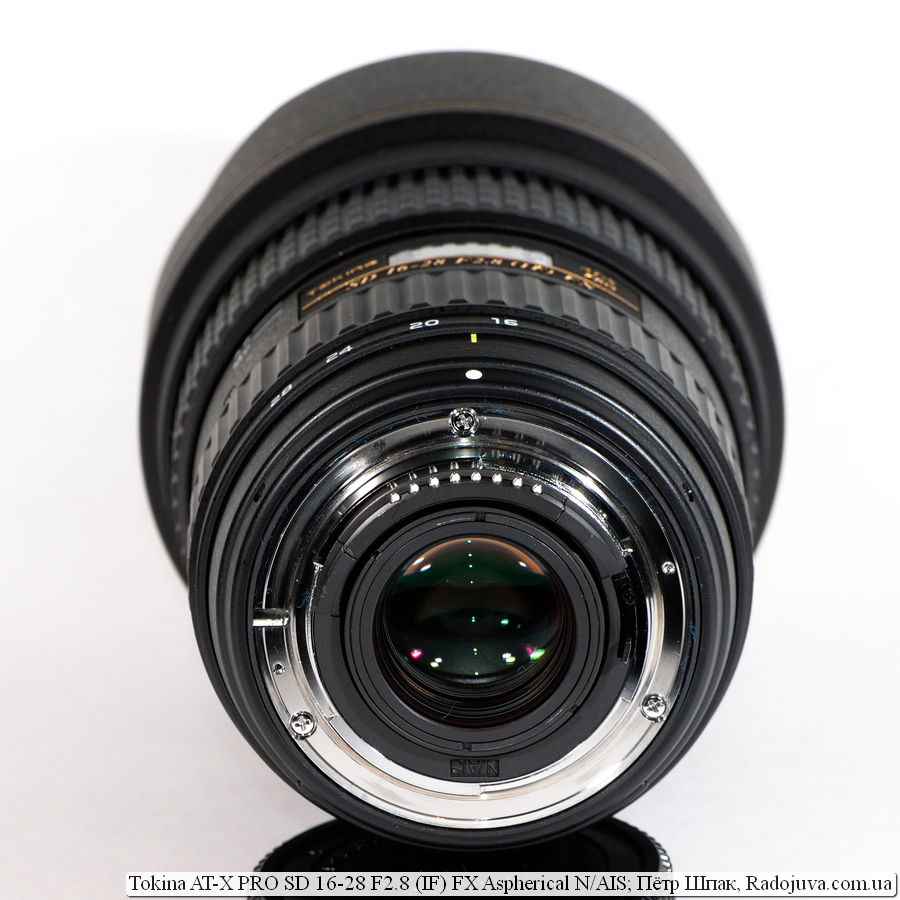Review of the Tokina AT-X PRO lens SD 16-28 F2.8 (IF) FX Aspherical N/AIS especially for Radozhiva prepared Peter Shpak.
The Tokina AT-X 16-28 f / 2.8 PRO FX lens is the best budget alternative to such ultra-wide lenses from Nikon and Canon. Unless, of course, you can find a specimen with accurate autofocus and lenses correctly calibrated along the axis. However, when it is possible to return the lens back to the seller, then in the end you will still come across a very suitable copy. I had to change such a lens only once. But still, on my camera Nikon D610 I need to set '-15' in the autofocus setting. The famous German website Photozone.de writes that they were lucky only the third time.
Tokina AT-X 16-28 f / 2.8 is available for Nikon and Canon, and is designed for full-frame cameras. For crop, it makes no sense to use such lenses, because all of their value is in the ultra-wide range of focal lengths.
The 'PRO' designation stands for superior quality lens. It is assembled very well, everything is fitted tightly, I have no complaints. This is a 'G' type lens with no aperture ring. The lens also has a built-in focusing motor, and is suitable for all Nikon DSLR cameras. Assembled in Japan.
Internal focusing - the front and rear lenses remain fixed. The zoom lens, on the contrary, is not internal - the front and rear lenses move back and forth, while moderately pumping air.
The front lens is huge and convex, so filters cannot be installed. For lovers of light filters, this is definitely a minus. I somehow don’t worry - the built-in hood is quite tolerable against impacts on various flat surfaces.
The optical design consists of 15 elements in 13 groups. Three elements are aspherical, three are made of low-dispersion glass, like Nikon's ED. The lenses are multi-coated. The lens holds back and side light very well. You need to try to catch hares. Basically, small glare comes from bright, narrow beam bulbs such as halogen reflectors.
MFD lens - 28 cm. Viewing angle - 107.1º-76.9º. Aperture - 9 rounded blades. It is not customary to talk about bokeh in ultra-wide lenses, they are not taken for portraits or for bokeh.
There are two rubberized rings on the lens. The smaller one, the zoom ring, rotates smoothly as expected. The larger ring is manual focus. To switch from autofocus mode, pull it towards you. In autofocus mode, it spins freely and does not affect anything, so you can safely hold on to it. The autofocus speed is average, in poor light and without contrasting details, it tends to travel a little back and forth. Focusing never blurs, but for some reason the camera's live view flatly refuses to work with it. Maybe it's specific Nikon D610.
The back of the lens has a rubber gasket, which means there is a certain level of dust and moisture protection.
A focal length of 16mm is not so ultra-short, but at the same time it is quite enough for most photo tasks. The fact is that the shorter the focal length of the lens, the more difficult it is to work with it. Already with 16mm it is not easy to cope, and with 14mm and even more so with 11mm difficulties begin at a completely different level.
The lens is sharp in the center of the frame already with f / 2.8. The edges and corners slightly sag, but this can only be seen on the monitor, with a 100% increase. On printed works it is extremely difficult to make out. At f / 4, the lens is sharp across the entire field of the frame.
Distortion is very moderate, less than the Nikon 14-24mm f / 2.8 AF-S G, a simple type. IN D610 she almost always straightens completely.
The Tokina AT-X 16-28 f / 2.8 lens is quite large and heavy - 946 g. It is difficult to fit into the case, taking up a lot of space. He sits in his hand, nothing dangles or rattles. It's a pleasure to work with him.

Tokina 16-28mm f / 2.8 and Nikon ED AF Nikkor 80-200mm 1: 2.8D MKIII
On the same Photozone.de this lens is praised, mentioning weak edges and corners at open aperture. I, in turn, did not notice this. In general, it is not clear how the Germans define sharpness there for such super-wide lenses. It seems that their depth of field plane is distorted when approaching infinity, that is, it becomes convex, as if in the shape of the front lens. If you look at the photos in the gallery, where the large rooms were shot, you can see that at f / 2.8 the walls, ceiling and floor are more or less in focus. At f / 4, sharpness is all over the frame. But at distances close to the MFD, the depth of field is practically flat (although I strongly doubt that it is perfectly flat). In the picture of the sideboard, the plates from the edges are closer, and you can see how they completely fall out of focus. (This is all just my assumption, I could not think of another explanation for this phenomenon). The maximum resolution is reached already at f / 4. The resolution is generally excellent. From the camera D610 I was able to print material for an exhibition measuring two by three meters. Everything was relatively sharp there, even if you look at it point blank.
I had the opportunity to compare this lens with Nikon ED AF-S Nikkor 14-24mm 1: 2.8G VR N Nano Crystal Coat SWM IF Aspherical, and I can say with certainty that he is not inferior to the native lens in terms of sharpness or image quality. And as you know, Nikon ED AF-S Nikkor 14-24mm 1: 2.8G VR N Nano Crystal Coat SWM IF Aspherical, (on a par with Canon EF 11-24mm f / 4 L) is the best ultra-wide lens of all, regardless of price and manufacturer. It is clear that here we are talking about shooting a real three-dimensional world, and not black and white squares and stripes hanging on the wall.
You can download RAW + JPEG source files at this link (26 files in '.NEF', '.JPEG' format, 754 MB). All photos were taken on Nikon D610.
You can see the real prices for the lens here, or in the price block below:
All prices on Tokina AT-X PRO SD 16-28
Conclusions
Tokina AT-X PRO SD 16-28 F2.8 (IF) FX Aspherical N/AIS is simply an excellent ultra-wide-angle lens, if you are lucky and can find a good one.
A list of all reviews from readers of Radozhiva will find here.























Give me a link to the front cover for this lens. If possible, Ukraine
Is there anyone with such a lens?
I forgot the magic word, known to everyone since childhood, in addition to “give”, that’s why they don’t answer. Courtesy is everything.
Good afternoon. All the peaceful sky above your head.
I would like to take a wide shot for shooting night landscapes with stars / milky way. If there are experienced users of this lens, then tell me how the lens behaves in the cold when you shoot for an hour, or even more for time-lapses and star tracks? His lens is convex, does it not fog up from the inside when taken out in the cold?
I ask because I have a Sigma 20 1.4 art, when taken out in the cold in winter, after 5-10 minutes, the outer lens fogs up from the inside. If you bring it into heat, then everything passes, no traces remain.
I choose between Tokina 16-28 2.8 and Tamron 15-30 2.8 the first version. Tamron is more expensive, so I'm looking at Tokina, but I'm very worried about the behavior of the lens. I don't want to get the same problem on two different lenses. The question of correct autofocus is not worth it at all, at night it is still manual focusing.